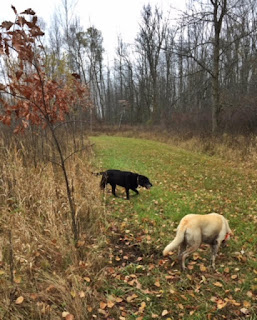Yesterday I blogged about flagging the property
boundaries as a first step in preparation for a logging operation. One of
the benefits of spending the better part of a day beating the bush is scouting
for deer sign. Not only did the dogs and
I jump about a half-dozen bedded whitetails - we also took note of evidence
that the rut (the breeding season) is now kicking into high gear.
scrape in the foreground - click to enlarge
Bucks create scrapes by using their hoofs to
dig at the ground. Once the soil is stirred up, they urinate on the scrape. Bucks don’t pee the way we do. We try to keep it off of us. Bucks actually try to pee on their own legs. The object is to hit their tarsal glands in an
effort to leave their scent on the scrape. Every deer has its own unique scent. The
tarsal glands hold concentrated amounts of that scent.
click on the image and you will see a deer stand forty yards distant
Another thing scrapes have is a licking
branch - a tree branch will hang above the cleared out soil. Bucks will rub their forehead glands on the
stick and will also lick it with their tongue.
Scrapes serve much the same function in the whitetail world as a mailbox
post or a fire hydrant does for dogs.
Scrapes are meant to show dominance over a territory but are normally
used by more than one buck.
click on any image to enlarge
Then there
are the rubs. It is a common
misconception that deer rubs on trees are caused by male whitetails attempting
to rub the velvet from their antlers.
While it would not be unusual for a velvet-antlered deer to rub against
a tree the rubbing seen at this time of year is a consequence of deer that have long-ago shed the velvet
from their antlers. The rub seen on these photos was
made by a dominant buck. Consider it
both a visual and a sensory calling card brought on by too much
testosterone.
red oak along the trail fifty yards from the house
It isn't unusual for other
bucks to add their contribution to the rub but it's more to do with
establishing the pecking order. The term
dominant buck is apropos given that one of the reasons for this behavior is to
mark their territory and curb the lesser bucks both psychologically and
hormonally. This suppresses testosterone
levels in the smaller bucks allowing the Big Guy to exert his influence and spread his seed during
the breeding season. The glands located
in the forehead of the dominant male send a signal that this is my turf. It also signals to the ladies of the male's
readiness to mate. Consider it the whitetail
equivalent of leaving your name and phone number with someone at the bar.
More later so stay tuned..








No comments:
Post a Comment